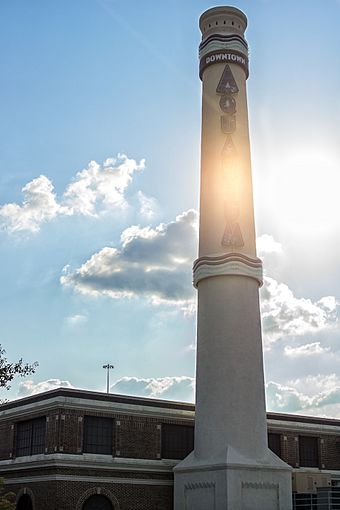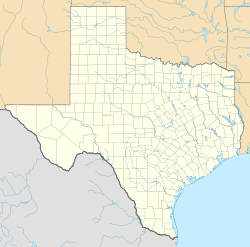1879 Houston Waterworks facts for kids
|
1879 Houston Waterworks
|
|
 |
|
| Location | 27 Artesian St., Houston, Texas |
|---|---|
| Area | 0.1 acres (0.040 ha) |
| Built | 1879 |
| Architect | Houston Waterworks Co. |
| NRHP reference No. | 76002037 |
Quick facts for kids Significant dates |
|
| Added to NRHP | May 6, 1976 |
The 1879 Houston Waterworks is an important historical building in Houston, Texas. It is listed on the National Register of Historic Places. This means it's a special place recognized for its history. This old water plant helped bring water to the growing city of Houston many years ago.
Contents
How Houston Got Its Water
In the late 1800s, Houston needed a way to get clean water to its people. A group of investors from New York decided to help. They started the Houston Water Works Company in 1878. This company made a deal with the city to build a water system.
Building the First Water System
The company built a dam on the Buffalo Bayou river. They also built a water treatment plant on Artesian Street. Pipes were laid to connect the plant to homes and businesses in the city. When it first opened in 1879, the plant pumped about 2 million gallons of water every day. This water was used for many things, including putting out fires. Just a few days after the plant opened, it helped fight a big fire on Main Street.
Finding New Water Sources
At first, the company used water from the Buffalo Bayou. But soon, people in Houston found natural underground water sources. These "artesian wells" provided cleaner water. The Waterworks company started using these wells, and they became more popular than private wells.
Upgrades and Challenges
In 1884, a new group took over the company. They added new equipment like boilers, pumps, and a bigger reservoir. This helped them pump up to 8 million gallons of water daily. Even with these improvements, it was sometimes hard to get enough water pressure to all parts of the city. This could be a problem when fighting fires.
By 1887, a new well showed there was a huge natural water supply underground. By 1891, the city had added 14 more wells.
City Takes Control of Water
In the early 1900s, the city of Houston found out that the Water Works company was mixing river water with the drinking water. This caused some funny, but also serious, problems.
Strange Discoveries in Pipes
In 1903, a three-foot-long eel was found blocking a water pipe! Three years later, a broken water pipe gushed out water with live catfish. These events made people joke that Houston's wells were full of eels and catfish.
Why the City Took Over
Houston's leaders, like Mayor Horace Baldwin Rice, realized the water system wasn't good enough. It couldn't provide enough clean water for everyone. So, in 1907, the city bought the Water Works system. They paid about $900,000 to take control. This included the water plant, 65 miles of water pipes, and 55 wells.
What Remains Today
By 1975, not much was left of the original 1879 Waterworks facility. There was a stone reservoir with a concrete cover. Some parts of the old pump house foundation might also still be there. These remains are on the same land as the Bayou Pumping Station, which was built in 1926.



